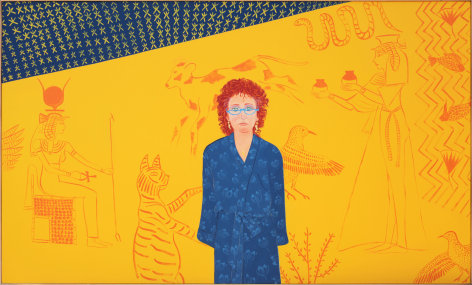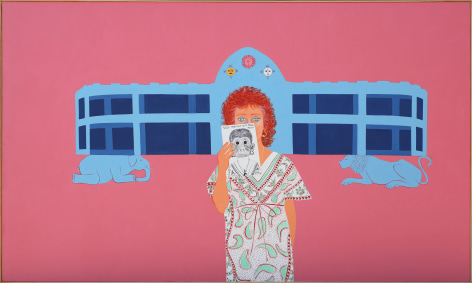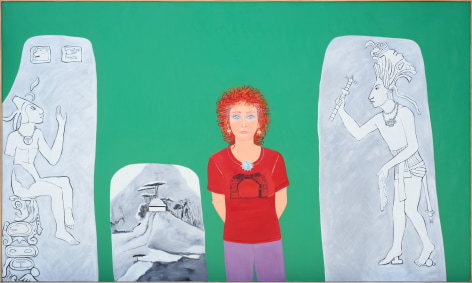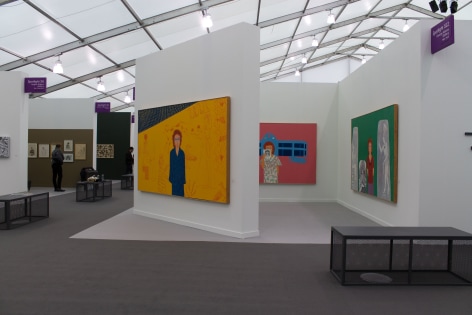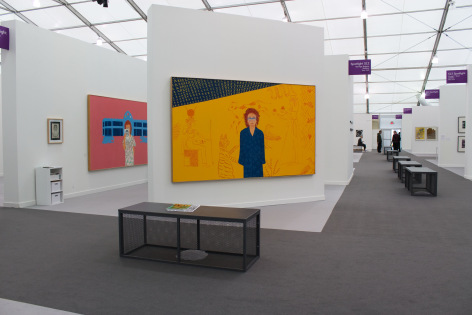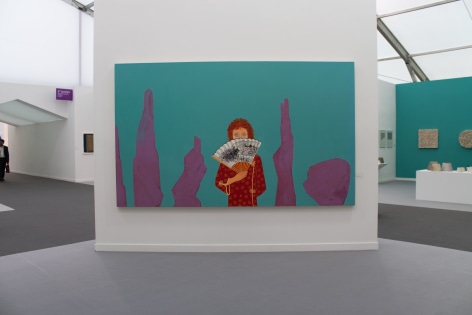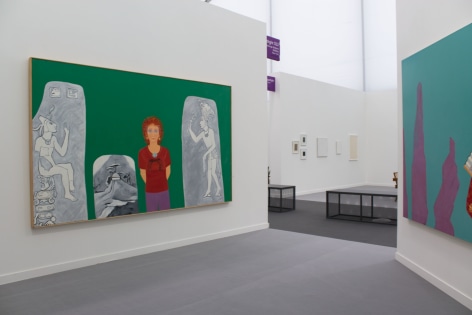For the Spotlight section in the upcoming New York edition of Frieze, we will be showing four monumental paintings by Joan Brown (1938-1990). All measuring 6 x 10 ft, they comprise a series of ‘Homage’s’ Brown painted in 1983 in recognition of the various ancient cultures, ideologies and individuals who impacted her thinking. Never before exhibited as a group, these four paintings represent a vital aspect of her later career, revealing an introspective and deeply spiritual artist at the peak of her ability.
Always inquisitive and open-minded, Joan Brown turned an enduring, youthful fascination with Egyptology into a life-long pursuit of beliefs and cultures around the world. With the help of a Guggenheim Fellowship in 1977, Brown traveled to Egypt for the first time; subsequent trips to South America, China, India and Mexico followed over the next five years. No tourist, Brown often traveled alone and made a point of accessing hard-to-reach destinations. She saw the purpose of these trips as an opportunity to “study ancient belief systems” which she supplemented with extensive research of her own. Brown was omnivorous in her study of art and keenly felt herself to be a student throughout her career: of old masters, ancient cultures, spiritual thinking. The ‘Homage’ paintings then represent a culmination of her studies as she both draws from and engages with the symbolism of each culture. Key themes include the reign of Egyptian pharaoh Akhenaton; Mayan god Quetzalcoatl, the spiritual teachings she gained in India and the mystic beauty of China’s Huangshan range.
While each painting functions as a self-portrait, they differ from her many other self-portraits of the period, which always show Brown as an artist in her studio. Instead, each ‘Homage’ does the opposite: her hands or face are obscured in a sign of respect and she surrounds herself with symbols of duality, harmony and wisdom. Color, image and content, all are filled with meaning - but more relevant to the series are the commonalities Brown saw between such disparate cultures, not only in systems of belief but in modes of representation. Reflecting on her travels in 1982, Brown commented, “These cultures influenced not only how I saw the art, but also how I saw the purpose of life. In other belief systems… that was expressed through what we call their ‘art.’” Addressing her own painting she adds, “I am very concerned that whatever elements are used have meaning and content; not just a good-looking image or an interesting image or a bad-looking image. I’m concerned that the images aren’t egocentric but also universal.”[i]
Joan Brown (1938-1990) was born in San Francisco, California where she lived and worked for most of her life. Almost by accident, Brown chose to attend the San Francisco Art Institute, studying under painters such as Elmer Bischoff and Richard Diebenkorn, going on to earn both her BFA (1959) and MFA (1960) at the school. Early recognition while Brown was still a student lead to her first solo exhibitions in San Francisco, at the Spasta Gallery (1958), in New York, at the Staempfli Gallery (1960) and in Los Angeles, at the Primus-Stuart Gallery (1962). Quickly named as one of the leading figures in the second generation of Bay Area Figurative painters, she was included in national survey exhibitions such as “Young America” at the Whitney Museum of American Art (1960), and at the Art Institute of Chicago (1961), the Carnegie International (1964), besides the definitive exhibition ’Funk’ at the Berkeley Art Museum (1967).
After taking a step back from her career in the mid-60s out of a desire to refocus her efforts, Brown emerged as a powerfully expressive figurative painter, working in the flat and colorful style most recognizably her own. Mid-career retrospectives at the San Francisco Museum of Art (1971), and the Berkeley Art Museum (1974) launched her into the second phase of her career, as she resumed a regular exhibition schedule with galleries in San Francisco (Hansen Fuller, 1973) and in New York (Allan Frumkin, 1974). Throughout her career, Brown showed herself to be a highly indivualistic artist, unswayed by trends or expectations of the market. Also a dedicated teacher, she held positions at SFAI and UC Berkeley, the later at which she eventually became department chair. By the mid-1980s, she began to shift her focus to public installations, which she felt were a more democratic form of art, completing several major commissions before her death in 1990. Frumkin/Adams, later George Adams, has continually exhibited her work as representatives of her Estate since. Brown’s work is included in many institutional collections, including the Museum of Modern Art, New York; San Francisco Museum of Modern Art; the Berkeley Art Museum; the Whitney Museum of American Art; the Art Institute of Chicago; the Museum of Fine Arts, Boston; the Philadelphia Art Museum; the Pennsylvania Academy of Fine Arts, Philadelphia; the Los Angeles County Museum; the Hirshhorn Museum and Sculpture Garden; Crystal Bridges; the Yale University Art Museum, and the Minneapolis Institute of Art. A major traveling retrospective of Brown’s work is currently being organized by the San Francisco Museum of Modern Art, scheduled for 2022-24.
i Interview with Lynn Gumpert, 1982. Published in Early Work, exh cat. The New Museum: New York: 1982. p 22.

